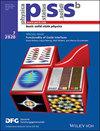Handles with Reentrant Cells for Use as Oar Handles: Design Considerations, Physical Characteristics, and End‐Users’ Perceptions
IF 1.8
4区 物理与天体物理
Q3 PHYSICS, CONDENSED MATTER
引用次数: 0
Abstract
Rowing is a sport that requires athletes to perform the action of pulling and rotating an oar by hand, applying forces of considerable magnitude. Herein, inspired by the notion that auxetic materials and metamaterials behave differently compared to their conventional counterparts, it is examined how a handle prototype, specifically designed to incorporate the classic re‐entrant motif, behaves and how end‐users perceive it. Physical experiments conducted on such prototype, which measured the contact pressures, suggest that on average, higher pressures are measured when pulling with this reentrant grip compared to its non reentrant counterpart, indicating that this re‐entrant prototype should feel firmer. More importantly, respondents of a survey are asked to give their feedback, and different views on which handle they would prefer to use are provided. The ones who preferred the prototype with the reentrant features report that they preferred it because it felt firmer and allowed for a better grip. This suggests that there is potential for further investigation into whether handles, oar handles in particular, made from auxetic components, re‐entrant cells, or other motifs which are well known for their negative Poisson's ratio characteristics, could provide a better and more secure grip and be used in sports applications.用作桨柄的带回游单元的手柄:设计考虑因素、物理特性和最终用户的看法
赛艇是一项要求运动员用手拉动和旋转桨叶的运动,需要施加相当大的力。受辅助材料和超材料的行为与传统材料不同这一概念的启发,本文研究了专门设计的手柄原型,该原型结合了经典的重入式图案,其行为如何,最终用户又是如何感知的。对这种手柄原型进行的物理实验测量了接触压力,结果表明,与非重入式手柄相比,使用这种重入式手柄拉动时平均压力更高,这表明这种重入式手柄原型应该感觉更坚固。更重要的是,在一项调查中,受访者被要求提供他们的反馈意见,并就他们更喜欢使用哪种手柄提出了不同的看法。那些喜欢具有重定向功能的原型的受访者表示,他们更喜欢这种原型,因为它感觉更坚固,握持感更好。这表明,我们有可能进一步研究由辅助元件、重陷单元或其他以负泊松比特性著称的图案制成的手柄(尤其是桨柄)是否能提供更好、更牢固的抓握感,并将其应用于体育运动中。
本文章由计算机程序翻译,如有差异,请以英文原文为准。
求助全文
约1分钟内获得全文
求助全文
来源期刊
CiteScore
3.30
自引率
6.20%
发文量
321
审稿时长
2 months
期刊介绍:
physica status solidi is devoted to the thorough peer review and the rapid publication of new and important results in all fields of solid state and materials physics, from basic science to applications and devices. Being among the largest and most important international publications, the pss journals publish review articles, letters and original work as well as special issues and conference contributions.
physica status solidi b – basic solid state physics is devoted to topics such as theoretical and experimental investigations of the atomistic and electronic structure of solids in general, phase transitions, electronic and optical properties of low-dimensional, nano-scale, strongly correlated, or disordered systems, superconductivity, magnetism, ferroelectricity etc.

 求助内容:
求助内容: 应助结果提醒方式:
应助结果提醒方式:


